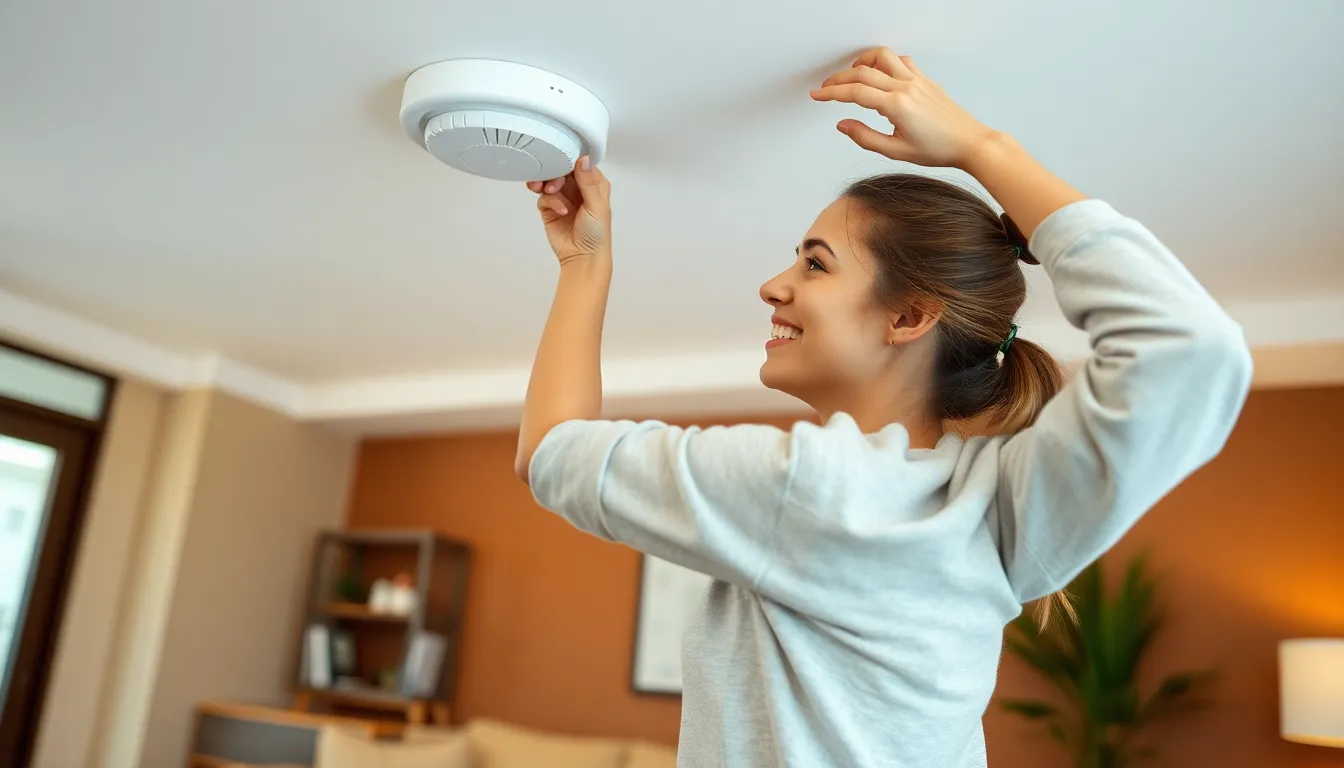When it comes to home safety, smoke alarms are the unsung heroes. They sit quietly on the ceiling, ready to spring into action at a moment’s notice, like a superhero waiting for the call. But let’s face it—if you haven’t installed one yet, your home might be more of a fire hazard than a cozy retreat.
Table of Contents
ToggleImportance Of Smoke Alarms
Smoke alarms serve a crucial role in maintaining home safety. These devices detect smoke and alert occupants to potential fire hazards, significantly increasing the chances of survival in an emergency.
Fire Safety Statistics
Fire incidents claim about 3,390 lives annually in the U.S. According to the National Fire Protection Association (NFPA), homes without smoke alarms face a higher risk of fire fatalities. Installation of smoke alarms decreases the risk of death in a fire by 50%. Furthermore, almost two-thirds of fire deaths occur in homes without working smoke alarms. Regular maintenance and testing improve their effectiveness.
Benefits Of Smoke Alarms
Smoke alarms provide several essential benefits. First, they offer early detection of smoke and heat, allowing people precious minutes to evacuate safely. Second, many modern models come with features like voice alerts and interconnected systems, enhancing safety. Third, smoke alarms can lower home insurance premiums, as insurers often reward homes equipped with them. Reliable and consistent protection makes them indispensable.
Types Of Smoke Alarms

Different types of smoke alarms cater to various fire detection needs. Understanding these options helps in choosing the right alarm for safety.
Ionization Smoke Alarms
Ionization smoke alarms excel at detecting fast flaming fires. They function by using a small amount of radioactive material to ionize the air in a sensing chamber. When smoke enters this chamber, it disrupts the ionization process, triggering the alarm. These types often respond faster to flaming fires than to smoldering fires. It’s crucial to install them in areas with potential fire hazards, such as kitchens or living rooms where cooking or open flames are frequent.
Photoelectric Smoke Alarms
Photoelectric smoke alarms are effective for detecting slow-smoldering fires. They utilize a light source and a sensor that identifies smoke particles by scattering light. This type responds more quickly to smoke from burning materials like furniture or upholstery. Positioning them in bedrooms or hallways enhances overall safety, as these areas commonly experience slow-burning fires. Many models include additional features like voice alerts, promoting timely evacuation.
Dual-Sensor Smoke Alarms
Dual-sensor smoke alarms incorporate both ionization and photoelectric technologies. They provide comprehensive protection by detecting both fast flaming and slow-smoldering fires. These alarms are advantageous because they offer wider coverage and enhanced reliability. Homeowners benefit from their dual capabilities, as they minimize false alarms while maximizing detection efficiency. Installing dual-sensor alarms throughout the home offers a robust safety solution that aligns with fire safety recommendations.
Smoke Alarm Installation Process
Installing smoke alarms ensures optimal safety in homes. The following sections detail the installation process.
Choosing The Right Location
Selecting the right location for smoke alarms affects their effectiveness. Ideally, place alarms in every sleeping area and outside each bedroom to ensure maximum coverage. Position alarms on ceilings or high on walls, as smoke rises. Avoid placing them near windows, vents, or areas with high humidity, like bathrooms. Consider installing alarms in hallways and common areas where fire is likely to spread quickly. Following these guidelines enhances detection capabilities and compliance with fire safety recommendations.
Step-By-Step Installation Guide
Start the installation by reading the manufacturer’s instructions specific to the smoke alarm model. Gather necessary tools including a drill, screwdriver, and level for proper mounting. Use a stud finder to locate joists if mounting on ceilings. Mark the required holes for screws, then drill, and secure the base of the smoke alarm. Attach the alarm by sliding or locking it into place. Finally, test the alarm to ensure it functions correctly. Regular checks and maintenance increase the lifespan and effectiveness of smoke alarms within the home.
Connecting To A Home Security System
Connecting smoke alarms to a home security system provides enhanced safety. Begin by determining if the existing system supports smoke alarms. If compatible, use the manufacturer’s guidelines to integrate the alarms seamlessly. Many systems allow for remote monitoring and alerts to be sent in case of an emergency. Ensure proper placement for optimal connectivity between alarms and the security panel. Regular testing of the systems ensures reliability, allowing quick response during emergencies and increasing overall safety for the household.
Maintenance And Testing
Regular maintenance and testing ensure smoke alarms function correctly and provide optimal safety protection. Testing smoke alarms monthly provides peace of mind. Homeowners should press the test button on each unit to verify the alarm sounds properly. If the alarm fails to activate, troubleshooting or replacement becomes necessary. Additionally, all alarms require cleaning every six months to remove dust and debris, which can interfere with performance. Following manufacturer guidelines supports maintaining your smoke alarms efficiently.
Regular Testing Procedures
Testing smoke alarms regularly enhances their reliability during emergencies. Monthly tests help confirm each unit operates correctly. Pressing the test button can provide an audible signal, while observing for any unusual sounds contributes further to assessing functionality. If multiple alarms are present, testing them simultaneously assures all are prepared to respond in case of fire. Documenting test dates promotes accountability and aids in keeping track of functionality.
Battery Replacement Tips
Replacing batteries in smoke alarms regularly is crucial for maintaining functionality. Homeowners should change batteries at least once a year or when alarms emit intermittent chirping sounds, signaling low battery power. Choosing lithium batteries often extends longevity, as they can last up to ten years without replacement. A straightforward approach includes marking the testing schedule and battery replacement dates on the calendar. This strategy ensures timely changes and extends the life of the smoke alarms, enhancing safety.
Smoke alarms are essential for protecting lives and property from fire hazards. Their ability to detect smoke and alert occupants can make a critical difference in emergencies. By choosing the right type of smoke alarm and installing it in strategic locations, homeowners can significantly enhance their safety.
Regular maintenance and testing are vital to ensure these devices function effectively. With the right precautions and a proactive approach, individuals can safeguard their homes and loved ones. Investing time and effort into smoke alarm installation and upkeep is a small price to pay for peace of mind and increased safety.





